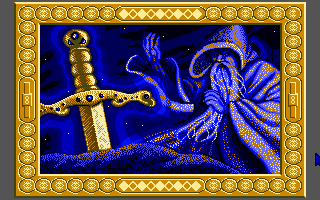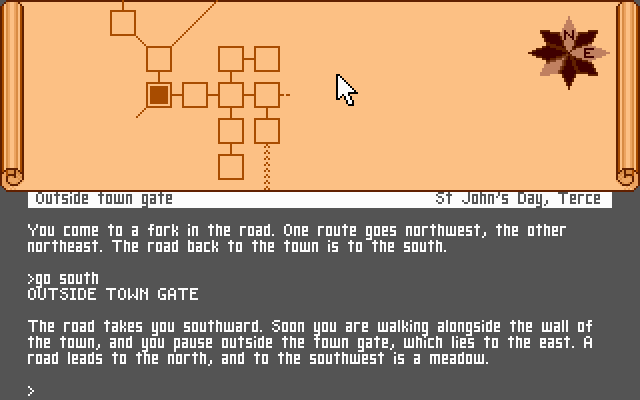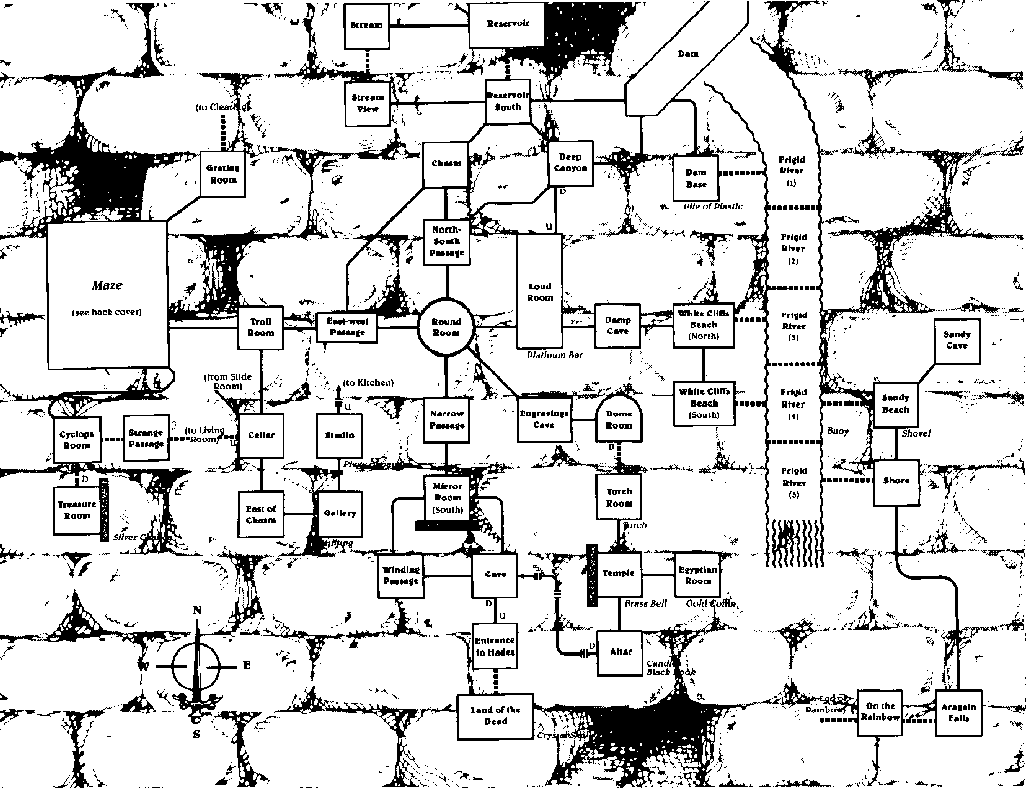Advantages, Maps, and Walkthrough
Arthur, the Quest for Excalibur offers special opportunities for middle school teachers, in addition to those that all good interactive fiction provides. To begin with, it dovetails well with traditional middle school curriculum, which often includes the Arthurian Legends. Also, unlike most versions of the Arthur stories, it offers a look at England in the fifth century AD, the period in which the historical Arthur, if there was one, actually lived; and a set of notes that contrasts this period with the thirteenth and fourteenth-century settings of most Arthurian tales.
Though Arthur does provide on-screen mapping, teachers may find more extensive maps of stories’ settings useful for their own planning, or even for use with students. Of course, distributing maps to students before they try a story will give away the solutions to some problems, but, the maps, as presented here, spoil very little of the fun and obviate a good deal of frustration.
You can find a complete set of maps for Arthur, using this link.
You can find a walkthrough for Arthur, here.
Formulating Problems in Arthur
Like other works of IF, Arthur offers some very rich opportunities for students to represent problems in a variety of ways, as they work toward solutions. Usually, my own classes maintain lists of problems and of restatements of problems, as they read works of IF. These lists help them to keep track of the multiple problems that they are working on, help them solve the problems, and, perhaps most important, give them a tool for looking back at, and thinking about, their problem-solving techniques.
Let’s take a look at some formulations and reformulations of problems that students typically create as they read Arthur.
Very early in the story, as the reader tries to start exploring, he or she encounters a problem in dealing with a curfew imposed by the evil King Lot. Here is a typical series of formulations of this problem:
| At first, students may ask, “How can I get out of the churchyard area?” | |
| Then, when the curfew-enforcing soldiers interfere, the problem may become, especially for relatively naive students, “How can I overcome the soldiers?” | |
| Soon, it becomes clear that an unarmed boy can’t defeat the soldiers, and so students usually ask, “Where can I hide from the soldiers?” | |
| Probably the most likely hiding place is the only nearby building, where the problem becomes, “In the church, where can I hide from the soldiers?” | |
| But there’s no good hiding place in the church, and this realization usually brings students to a more or less final formulation of this problem, “In the churchyard, where can I hide from the soldiers?” This question leads leads students to have Arthur hide, successfully, behind one of the gravestones. |
Later, as he or she continues to explore, the reader encounters a deadly-treacherous bog, but a person who knows the way through turns out to be close at hand. Here is a series of reformulations of this problem.
| The problem may begin as, “How can I get through the treacherous peat bog?” | |
| When the readers realize that the bog is a kind of maze, in which one false step can cause disaster, they may formulate the problem in a way that takes into account the need for some sort of map: “How can I get directions for getting through the bog?” | |
| Once they know that they need directions, students usually ask, “Where can I find someone who might know his or her way through the bog?” | |
| By the time they get to the bog, students have usually found an unconscious character who apparently lives near the swamp, and so they ask, “How can I awaken the peasant?” | |
| But, in order to awaken the unconscious man, the reader must figure out, “What’s wrong with the peasant?” | |
| Some hints in the description of the unconscious man’s dwelling often lead students to ask, “What’s wrong with the peasant’s cottage?” | |
| And, since the cottage is described as very cold, the problem may become, “How can I warm up the cottage?” | |
| The cottage does have a smoldering fire, and so students may ask, “Where can I get fuel for the peasant’s fire?” | |
| If they have learned what peat is, the readers may now change the problem to, “How can I get some dry peat?” | |
| Students find that, though dry peat is easy to find at the edge of the bog, it’s very hard to dig it out. As a result, they soon ask, “What sort of tool would be good for digging up peat?” | |
| Outside the peasant’s cottage, the students have already found an object with an unfamiliar name, and so they may inquire, “What is a slean?” | |
| Then, they may ask, “How can I find out what a slean is?” If they are catching on to the old interactive fiction rule, “Examine everything,” they will quickly solve this problem. | |
| Once the cottage is warmed up, the peasant regains consciousness and reveals that he does, indeed, work in the peat bog, but it’s clear that he is suffering from a leg injury. As a result, student will often ask, “How can I help the peasant further?” though this question may not seem directly related to getting through the bog. It turns out that Arthur can help the man by giving him his crutch, which has been left outside the cottage. | |
| Once Arthur is in the peasant’s good graces, the students may ask, “How can I find out what the peasant knows about the bog?” When they ask the peasant about the bog, he gives them directions to get through it. |
Supplementary Materials for Arthur
Arthur includes maps and hints which are incorporated into the computer program itself. However, like other Infocom stories, it requires additional supplementary materials, which, originally, came with the story in hard-copy form. Today, you can find these materials at the website called “The Infocom Documentation Project,” which resides at http://infodoc.plover.net. The manual for Arthur, which you’ll find at the Documentation Project, offers some important poetic materials, including a poem in which the narrator is Merlin, who appears briefly in the story. Another bit of verse, which appears at the beginning of a Book of Hours, praises King Lot, the villain of the tale. Each poem contains information that the reader needs in order to solve a particular problem in the narrative.



